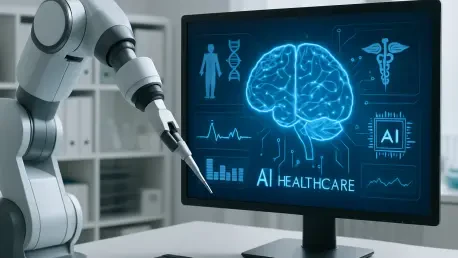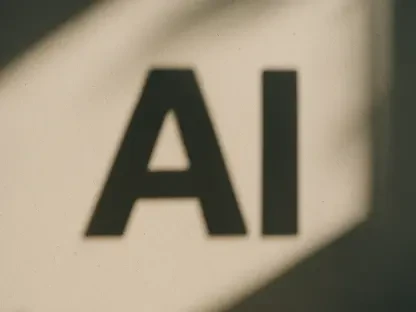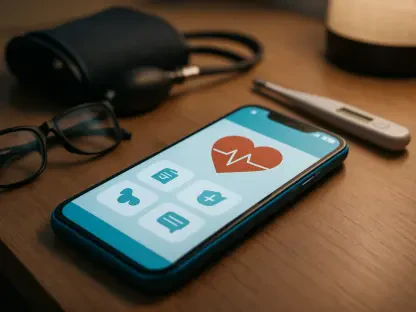Imagine a world where surgeries are performed with pinpoint accuracy, free from the limitations of human error, and where patients recover faster due to minimally invasive techniques. This is no longer a distant dream but a reality unfolding in hospitals worldwide, thanks to the rapid rise of medical robotics. The integration of robotic systems in healthcare is revolutionizing surgical precision and patient outcomes, addressing long-standing challenges in complex procedures. This roundup gathers insights, opinions, and reviews from various industry perspectives to explore how these technologies are reshaping the medical field, spotlighting key innovations and the diverse viewpoints surrounding their adoption.
Cutting-Edge Developments in Medical Robotics
Monogram Technologies’ Autonomous Knee Replacement Milestone
Industry observers have hailed Monogram Technologies’ mBôs TKA system as a groundbreaking step in orthopedic surgery after it achieved the world’s first fully autonomous knee replacement in India. Reports from clinical settings emphasize that this system, part of a trial involving over 100 procedures, has demonstrated remarkable precision in executing total knee replacements without direct human intervention. Many in the field view this as a potential game-changer, reducing variability in surgical outcomes and minimizing stress on medical teams during intricate operations.
Feedback from orthopedic specialists suggests that the technology’s ability to perform flawlessly, as seen in trial results, could redefine standards in joint replacement surgeries. The semi-autonomous version of the system, which has already gained FDA clearance, is often cited as a stepping stone toward broader acceptance. However, some experts caution that while the innovation is promising, ensuring consistent results across varied patient demographics remains a critical concern for scaling up.
A recurring theme in discussions is the challenge of global scalability. Commentators from developing regions note that while the technology shows immense potential, the infrastructure and training required for widespread adoption could pose significant hurdles. Opinions vary on how quickly such systems can integrate into diverse healthcare environments, with some advocating for phased implementation to address these logistical barriers.
Stereotaxis’ Precision in Cardiac Mapping Technology
Stereotaxis’ FDA-cleared electrophysiology mapping catheter has garnered significant attention for its role in treating cardiac arrhythmias through robotic navigation systems. Industry reviews highlight how the catheter, equipped with multiple electrodes for high-density data collection, enables faster and more accurate heart mapping. Many cardiologists and technologists praise its integration with robotic platforms, noting that it offers a level of detail previously unattainable in arrhythmia diagnostics.
Insights from cardiac care professionals underscore the real-world impact of this advancement, with many pointing to improved procedural efficiency and patient safety. The ongoing progress of Stereotaxis’ GenesisX system, which has received Europe’s CE mark and is under FDA review as of 2025, is often mentioned as evidence of the company’s commitment to pushing boundaries. Yet, some in the field express concerns over the high costs associated with adopting such sophisticated tools, which could limit access in smaller medical facilities.
Differing views emerge on the learning curve required for cardiologists to fully utilize these systems. While some experts argue that comprehensive training programs can bridge this gap, others worry that the complexity might slow adoption rates, particularly in under-resourced settings. This debate reflects a broader tension between innovation and practical implementation within the cardiac care community.
Broader Trends in Robotic Healthcare Solutions
The trend toward greater autonomy in medical robotics is a hot topic among healthcare technologists, with many pointing to systems like those from Monogram and Stereotaxis as harbingers of fully integrated surgical environments. Discussions often focus on how these technologies could streamline workflows, allowing for more consistent outcomes across various procedures. Enthusiasm is particularly high in tech-forward regions like Europe, where adoption rates are reportedly accelerating due to supportive regulatory frameworks.
Regional disparities in implementation spark varied opinions, with some industry voices noting that resource-limited areas face significant barriers to accessing these tools. Speculation abounds on how artificial intelligence could further enhance robotic capabilities, potentially predicting patient-specific needs during surgeries. However, a minority of commentators raise ethical questions about over-reliance on automation, urging a balance between technological precision and human oversight.
Contrary to fears that robotics might depersonalize patient care, many professionals argue that these systems could free up time for doctors to focus on building stronger patient relationships. This perspective posits that by handling repetitive or high-precision tasks, robots enable a more empathetic approach to medicine. Such optimism fuels ongoing debates about the role of technology in maintaining the human element of healthcare.
Connecting Orthopedics and Cardiology via Robotics
A common thread in expert analyses is the shared emphasis on precision and efficiency that robotics brings to fields as diverse as orthopedics and cardiology. Commentators often draw parallels between Monogram’s knee replacement systems and Stereotaxis’ cardiac mapping tools, noting how both reduce procedural errors and improve recovery times. This synergy is seen as a blueprint for applying robotic solutions across other medical specialties.
Industry perspectives frequently highlight the complementary nature of these innovations, with many envisioning future hybrid platforms that could address multiple health issues simultaneously. Some specialists speculate that the reduced physical and mental strain on surgeons, as observed in current applications, could inspire similar advancements in areas like neurology or oncology. This cross-disciplinary potential is a recurring point of excitement in professional forums.
Exploratory discussions also touch on how these technologies might evolve to tackle entirely new medical challenges. For instance, insights from interdisciplinary panels suggest that lessons learned from orthopedic and cardiac robotics could inform minimally invasive approaches in other domains. While speculative, these scenarios underscore a collective belief in the expansive possibilities of robotic integration in healthcare.
Key Takeaways and Practical Applications
Synthesizing the roundup, the standout contributions of Monogram Technologies and Stereotaxis emerge as focal points for safer surgeries and enhanced diagnostics. Reviews consistently emphasize that robotic precision addresses critical gaps in traditional medical approaches, with industry leaders advocating for increased investment in such technologies. The consensus points to a transformative shift, where robotic systems are becoming indispensable allies in complex procedures.
For healthcare providers, actionable advice includes prioritizing training programs to familiarize staff with robotic systems, ensuring smoother transitions in clinical settings. Policy recommendations often surface in discussions, with many urging hospital administrations to advocate for funding and regulatory support to integrate these tools effectively. This practical guidance aims to bridge the gap between innovation and everyday application.
Beyond professional circles, curious individuals and advocates are encouraged to stay informed about robotic advancements through reputable industry updates and educational resources. Supporting innovation can take the form of engaging with public health initiatives that promote equitable access to cutting-edge care. These steps, as suggested by various stakeholders, empower broader communities to contribute to the evolving landscape of medical technology.
Reflecting on the Journey of Medical Robotics
Looking back, the insights gathered from diverse industry perspectives paint a vivid picture of progress in medical robotics, with Monogram Technologies and Stereotaxis leading pivotal advancements in their respective fields. The discussions captured a spectrum of optimism and caution, reflecting a nuanced understanding of how these technologies reshape surgical and diagnostic practices. Their impact is evident in the enhanced precision and efficiency that mark a new chapter in patient care.
Moving forward, the focus should shift to ensuring that these life-changing tools become accessible to all, regardless of geographic or economic barriers. Healthcare systems are encouraged to explore partnerships and funding models that democratize access to robotic innovations. Additionally, fostering continuous dialogue among technologists, clinicians, and policymakers will be crucial to address emerging challenges and sustain the momentum of this transformative era in medicine.









